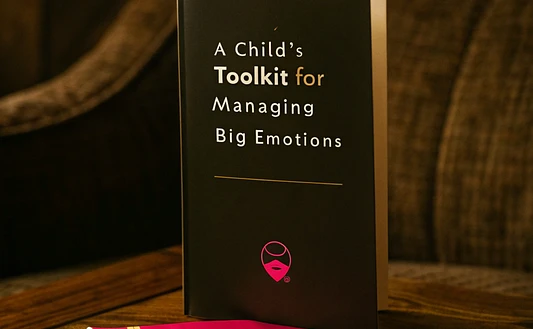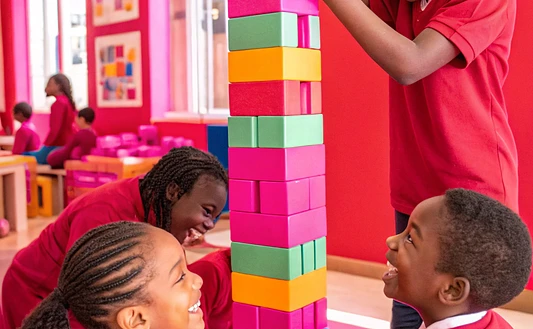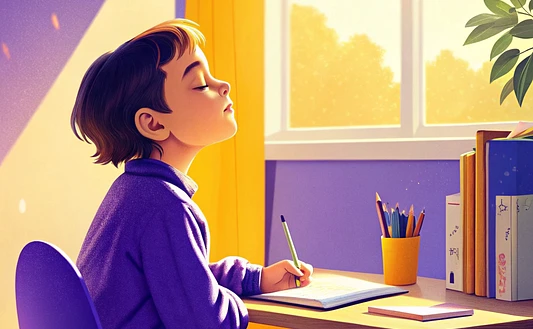The Self-Regulation Superpower: A Child's Toolkit for Managing Big Emotions
The Self-Regulation Superpower
Complete Book Description & User Guide
📖 BOOK DESCRIPTION
The Self-Regulation Superpower: A Child's Toolkit for Managing Big Emotions is a transformative guide designed for children ages 6-12 and their parents. This practical eBook bridges the gap between neuroscience and everyday family life, offering proven strategies to help children understand, navigate, and manage overwhelming emotions.
Unlike traditional parenting books that focus solely on behavior modification, this guide takes a brain-based approach. It explains why children have emotional outbursts (spoiler: it's neurology, not defiance), and provides concrete, actionable tools that work with a child's developing nervous system rather than against it.
Written in two voices—one for parents and one directly for children—this book creates a shared language and understanding around emotions. Parents gain insight into their child's neurological development and learn co-regulation techniques, while children discover their own "superpowers" through fun, engaging activities they can actually use when emotions run high.
The book covers everything from identifying early warning signs of big feelings to creating personalized calm-down plans. It includes breathing exercises, sensory strategies, movement activities, and guidance for setting up a dedicated calm-down space at home. Most importantly, it normalizes emotional struggles and frames regulation as a learnable skill, not a character trait.
With its warm, shame-free tone and evidence-based content, The Self-Regulation Superpower is the guidebook every family needs to transform emotional chaos into opportunities for growth, connection, and resilience.
🌟 KEY BENEFITS
For Children:
Emotional Empowerment
- Children learn they have control over their emotional responses, reducing feelings of helplessness
- Builds confidence through mastering practical skills that actually work
- Creates a sense of competence: "I can handle this"
Improved Self-Awareness
- Develops the ability to recognize emotions early, before they become overwhelming
- Teaches body-awareness and emotional literacy (naming feelings accurately)
- Helps children understand the connection between physical sensations and emotions
Practical Coping Skills
- Provides a toolkit of 15+ evidence-based techniques for different emotions and situations
- Offers strategies that work quickly and can be used anywhere (school, home, friends' houses)
- Teaches lifelong skills that remain valuable into adolescence and adulthood
Better Relationships
- Reduces conflict with siblings, parents, and peers through improved emotional control
- Increases empathy as children understand that everyone experiences big feelings
- Strengthens parent-child bond through shared language and co-regulation experiences
Academic and Social Success
- Improved focus and attention when emotions aren't hijacking the brain
- Better problem-solving abilities when the prefrontal cortex can function properly
- Increased resilience when facing challenges or disappointments
For Parents:
Understanding and Relief
- Replaces guilt and frustration with understanding of child development and neuroscience
- Provides reassurance that tantrums are neurological, not character flaws or parenting failures
- Reduces parental anxiety about their child's emotional development
Effective Tools That Actually Work
- Moves beyond "calm down" to specific, actionable strategies
- Provides alternatives to punishment-based approaches that often escalate situations
- Offers immediate interventions for crisis moments and long-term skill-building strategies
Co-Regulation Framework
- Teaches parents how to be their child's "borrowed nervous system"
- Provides scripts and techniques for staying calm when your child isn't
- Creates a roadmap from other-regulation (for young children) to self-regulation (the goal)
Reduced Household Conflict
- Fewer meltdowns and shorter recovery times when they do occur
- More peaceful mornings, bedtimes, and transitions
- Siblings learn the same techniques, reducing conflicts between children
Confidence in Parenting
- Clear guidance removes the guesswork from handling emotional outbursts
- Provides language for discussing emotions that feels natural and supportive
- Empowers parents to trust the process and their own capabilities
Long-Term Investment
- Skills learned now prevent bigger problems in adolescence
- Creates emotionally intelligent children who become emotionally healthy adults
- Builds family resilience that lasts across challenging life transitions
For the Whole Family:
Shared Emotional Language
- Everyone uses the same vocabulary and concepts around feelings
- Creates understanding across generations (grandparents can use these tools too)
- Reduces misunderstandings and increases empathy
Calmer Home Environment
- Overall reduction in stress and tension
- More positive interactions and quality time together
- Creates a home culture where emotions are safe and manageable
Breaking Generational Patterns
- Many adults never learned these skills; teaching your child breaks the cycle
- Models healthy emotional processing for the next generation
- Creates new family norms around discussing and handling feelings
📚 HOW TO USE THIS BOOK
Getting Started (Week 1):
For Parents:
- Read "A Note for Grown-Ups" first - This foundation is crucial for understanding your role
- Read Chapter 1 on your own - Understand the neuroscience before teaching it to your child
- Reflect on your own emotional regulation - You can't teach what you don't practice
- Commit to the process - This is a marathon, not a sprint; results take time and consistency
With Your Child:
- Introduce the book together - Read "A Note for Kids!" aloud in a cozy, relaxed setting
- Read Chapter 1 together - Use simple language and ask if they have questions
- Make it interactive - "Can you point to where you think your brain's alarm is?" "What does your face feel like when you're angry?"
- Keep sessions short - 10-15 minutes is plenty for young children
Building the Foundation (Weeks 2-3):
Chapter 2: Becoming a Feelings Detective
- Work through this chapter together over 2-3 days
- Complete the "Feeling Thermometer" activity together
- Practice "sportscasting" during calm moments: "I notice you're smiling and bouncing. You seem excited!"
- Start checking in daily: "Where are you on your feeling thermometer right now?"
Chapter 3: Breathing Superpowers
- Practice one breathing technique per day during calm times
- Make it fun: have breathing races (who can do snake breath longest?), practice before bedtime, or during TV commercial breaks
- Let your child choose their favorite breathing technique
- Practice together - your child needs to see you using these tools too
Chapter 4: Sensory Toolbox
- Try one new sensory activity each day
- Notice which ones your child gravitates toward naturally
- Create your calm-down corner together (this is crucial - make it special!)
- Stock the corner with chosen tools and sensory items
Integration and Practice (Weeks 4+):
Chapter 5: Creating the Personal Plan
- Complete the "My Personal Superpower Plan" worksheet together
- Post it where your child can see it (refrigerator, bedroom door, calm-down corner)
- Review and update it monthly as preferences change
Daily Practice Routine:
- Morning: "Let's do 5 belly breaths before school to start the day calm"
- After school: "How are you feeling? Where on your thermometer?"
- Before bed: Practice breathing or do a calming sensory activity together
- During calm moments: Randomly practice techniques so they become automatic
During Emotional Moments:
- Stay calm yourself first (use your own tools!)
-
Assess the feeling thermometer level
- At 8-10: Focus on co-regulation, your calm presence, don't teach
- At 5-7: Gently suggest trying a tool together
- At 3-4: Praise for noticing and encourage using a tool independently
- Offer limited choices: "Would you like to try wall pushes or snake breathing?"
- Stay present without forcing
- Debrief later: "What worked? What didn't? What could we try next time?"
Advanced Use (Ongoing):
Make It Part of Your Culture:
- Use the language regularly: "I'm at a 7 on my thermometer, so I'm going to take a break"
- Normalize using tools: "I'm going to do some deep breathing before this phone call"
- Praise effort over outcomes: "I'm so proud you tried square breathing, even though you were still upset"
- Evolve as your child grows: add new techniques, retire ones that no longer work
Expand Beyond Home:
- Share techniques with teachers (with permission)
- Practice using "sneaky" tools in public (pocket fidgets, invisible breathing)
- Teach siblings and friends
- Use during difficult transitions (doctor appointments, travel, new situations)
Troubleshooting:
- If nothing seems to work: Your child might be too dysregulated; focus on your calm presence first
- If your child refuses to practice: Make it fun, not a chore; use games and challenges
- If you're feeling overwhelmed: Read the FAQ section and "When to Seek Help"
- If progress plateaus: This is normal; keep practicing and trust the process
Important Reminders:
✅ Practice during calm times - This cannot be overstated; crisis is not teaching time ✅ Be patient - Brain development takes years; small improvements are still improvements ✅ Stay consistent - Use the same language and techniques repeatedly ✅ Model the behavior - Your regulation is the most powerful teaching tool you have ✅ Celebrate small wins - A 30-minute meltdown becoming 20 minutes is progress ✅ Adjust as needed - What works today might not work tomorrow; stay flexible
💡 WHY THIS BOOK MATTERS
The Crisis We're Facing:
Rising Childhood Anxiety and Emotional Dysregulation
- Mental health challenges in children have increased dramatically over the past decade
- According to the CDC, anxiety and depression in children ages 3-17 increased by 29% between 2016-2020
- The American Academy of Pediatrics declared a national emergency in child and adolescent mental health in 2021
- Many children are reaching adulthood without basic emotional regulation skills
The Gap in Traditional Approaches
- Traditional discipline focuses on behavior modification without addressing the underlying neurology
- Many parents received messages like "stop crying" or "you're overreacting" in their own childhoods
- Schools are overwhelmed and often lack resources for social-emotional learning
- Mental health services have long wait lists and aren't accessible to everyone
The Long-Term Cost of Not Learning These Skills
- Children who don't learn regulation are at higher risk for:
- Anxiety and depression in adolescence and adulthood
- Substance abuse as a coping mechanism
- Relationship difficulties and conflict
- Academic and career challenges
- Physical health problems (stress affects the body)
- Lower quality of life overall
Why This Approach Works:
Brain-Based and Evidence-Informed
- Grounded in neuroscience, polyvagal theory, and attachment research
- Techniques are backed by decades of research in child development
- Works with the brain's natural development rather than against it
- Focuses on building neural pathways through repeated practice
Addresses Root Causes
- Goes beyond surface behavior to address nervous system dysregulation
- Teaches children to understand the "why" behind their emotions
- Provides tools that work on a physiological level (breathing affects the vagus nerve, sensory input calms the nervous system)
- Creates lasting change rather than temporary compliance
Accessible and Practical
- No expensive equipment or therapy required (though therapy can complement these tools)
- Techniques can be used anywhere, anytime
- Written in plain language without jargon
- Designed for real families with real constraints (time, stress, resources)
Preventive and Empowering
- Prevents small emotional challenges from becoming big mental health issues
- Builds resilience before crisis hits
- Empowers children with agency over their own emotional experiences
- Creates competent, confident kids who know they can handle hard things
The Ripple Effect:
Individual Impact When a child learns self-regulation, they gain:
- Better academic performance (regulated brains can focus and learn)
- Stronger friendships (emotional control improves social interactions)
- Improved physical health (less chronic stress on the body)
- Higher self-esteem (mastery builds confidence)
- Greater life satisfaction overall
Family Impact When families adopt these practices:
- Parents experience less stress and guilt
- Sibling relationships improve
- Family time becomes more enjoyable
- Communication opens up around difficult topics
- Generational trauma patterns can be interrupted
Societal Impact When we raise emotionally regulated children:
- We create adults who can handle conflict constructively
- We reduce violence, addiction, and mental health crises
- We build emotionally intelligent leaders, parents, and community members
- We create a more compassionate, resilient society
Why Now Matters:
The Window of Development
- The brain is most plastic (changeable) during childhood
- Neural pathways established now become the foundation for life
- Early intervention prevents problems from becoming entrenched
- Skills learned in childhood become automatic in adulthood
The Current Moment
- We're living in unprecedented times of stress and change
- Children today face challenges previous generations didn't (social media, pandemic aftermath, climate anxiety)
- Traditional support systems (extended family, tight-knit communities) have weakened
- Parents need tools now more than ever
The Opportunity
- We have access to research and knowledge previous generations didn't have
- We can break cycles of emotional suppression or dysregulation
- We can give our children tools we wish we'd had
- We can create a different future, one child at a time
Personal Testimony to Consider:
Imagine your child at age 25. They're facing a stressful situation—maybe a difficult boss, a relationship conflict, or a major disappointment.
Without these skills, they might:
- Explode in anger and say things they regret
- Shut down emotionally and withdraw
- Turn to unhealthy coping mechanisms
- Feel helpless and overwhelmed
- Repeat patterns that have held them back for years
With these skills, they might:
- Notice their feeling thermometer rising
- Excuse themselves to take a few deep breaths
- Use their tools to calm their nervous system
- Return to the situation thinking clearly
- Handle it maturely and feel proud of themselves
That's the difference this book can make.
These aren't just techniques for managing childhood tantrums. These are life skills that compound over time, creating adults who are resilient, emotionally intelligent, and capable of handling whatever life throws at them.
The Bottom Line:
This book matters because:
- Emotions are inevitable; regulation is learnable
- Early intervention changes life trajectories
- Parents need support, not judgment
- Children deserve tools, not just consequences
- Mental health starts with daily practices, not just crisis intervention
- The investment you make today in your child's emotional development will pay dividends for their entire life
You're not just reading a book. You're embarking on a journey that could fundamentally change your family's emotional culture and your child's future.
That's why this book matters.
And that's why your decision to engage with it matters too.
Welcome to the journey. Let's build those superpowers together.
"The greatest gift you can give your child is not freedom from difficult emotions, but the tools to navigate them with grace, strength, and self-compassion."



